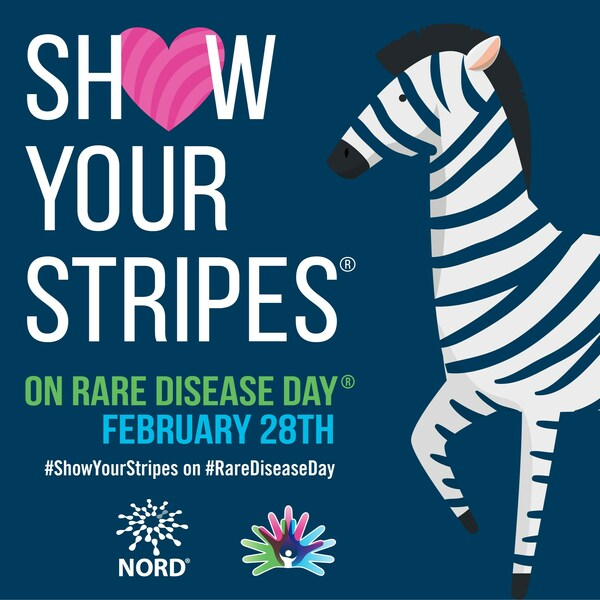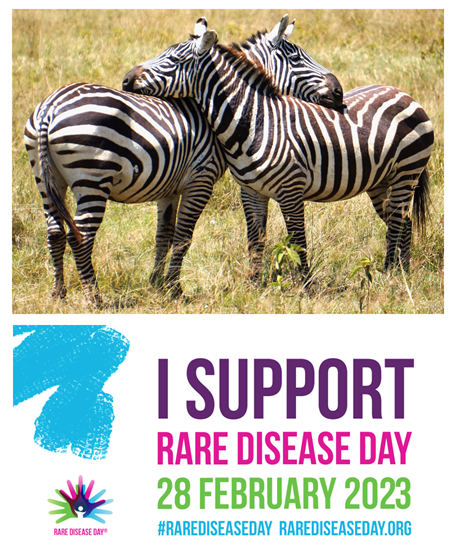By Kylie Vermeire and Sue Jaspersen
‘When you hear hoofs, think horses, not zebras.’ Rare diseases are medical zebras, conditions that individually affect a small number of people. Although each disease may be individually rare, approximately 1 in 10 Americans will be diagnosed with a rare disease in their lifetime. Together, the number of people in the United States affected by rare diseases (over 30 million) is like that of a common disease such as diabetes (37.3 million) and greater than that of Alzheimer’s disease (6.5 million) or heart failure (6.2 million). Rare Disease Day is a patient-led opportunity to shine a light on the zebras.
What is a rare disease?
A disease is designated as ‘rare’ if it affects fewer than 1 in 2,000 people. Examples of rare diseases include more than 500 types of cancer, cystic fibrosis, and muscular dystrophy. Over 80% of rare diseases are caused by changes in one’s DNA. Genetic counselors are often involved in the diagnosis of rare diseases, from genetic testing to providing information and support resources.
Who is affected by rare disease?
Over 7000 rare diseases affect people around the world. Half of the affected people are children. 95% of all rare diseases do not have an approved treatment.
How is a rare disease diagnosed?
Each disease requires its own set of tests. Many people with a rare disease report a ‘diagnostic odyssey’ in receiving a diagnosis. Often rare diseases are misdiagnosed. New symptomsmay develop, or symptoms could worsen before the rare disease is diagnosed. Medical testing can be expensive, and the lack of answers along the way can be frustrating and isolating.
How do rare diseases affect everyday life?
Individuals with rare diseases can have complex medical needs. Some may need assistance with daily living or adaptive medical equipment such as walkers or wheelchairs. Frequent medical appointments can require time off from work and travel to specialized care centers. Limited insurance coverage for rare diseases often creates a significant financial strain for people and families affected by a rare disease.
What can I do about rare diseases?
The European Rare Disease Organization (EURODIS) first celebrated on the rarest calendar day, February 29, 2008. The National Organization for Rare Disorders (NORD) partnered with EURODIS in 2009 to celebrate Rare Disease Day in the United States on the last day of February. The goal of Rare Disease Day is to raise awareness for rare diseases. You can do the following:
1. Show your support for rare diseases. February 28th,2023, is Rare Disease Day. A zebra is the symbol for rare diseases in the US, so wear your striped shirt and share a picture of it on social media with the hashtags #ShowYourStripes and #RareDiseaseDay to promote awareness or rare diseases.

2. Learn more about rare diseases. You can visit https://rarediseases.org to learn more about rare diseases, find support and resources, and ways that you can get involved in the rare disease community. Listen to the Podcast series Raring from OffScrip Health, which featurespatient advocates, medical experts, and family memberssharing information related to rare disease.
3. Share your knowledge of rare diseases. Rare things become common when we talk about them and spread information to other people. You can share this blog with your network. Speak up to let policy makers know the importance of rare disease research and treatment. If you have been affected by a rare disease, consider sharing your story with others, joining the hooves of many zebras.
4. Participate in a Rare Disease Day Event. Consider joining an event to show support and raise awareness of rare diseases. You can also fundraise for a rare disease organization.
Authored by Kylie Vermeire and Sue Jaspersen, genetic counseling interns in their final semester at the University of Nebraska Medical Center. Both strive to advocate for patients with rare diseases through genetic counseling, community involvement, and social awareness.
